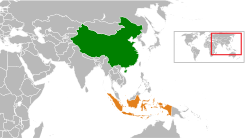China-Indonesia relations
 |
|
|
China |
Indonesia |
|---|---|
China–Indonesia relations refer to the foreign relations between China and Indonesia. The relations between two nations have been ongoing for centuries, and were officially recognized in 1950. However the diplomatic relationship between the two states was suspended in 1967, and then resumed in 1990. China has an embassy in Jakarta and consulates in Surabaya and Medan, while Indonesia has an embassy in Beijing and consulates in Guangzhou, Shanghai and Hong Kong. Both countries are among the largest nations in Asia in terms of both area and population, China is the most populous nation on earth, while Indonesia has the 4th largest population in the world. Both nations are the members of APEC and G-20 major economies.
According to a 2014 BBC World Service Poll, the opinion of China among Indonesians remains strongly positive and stable, with 52% of positive view compared to 28% expressing a negative view.
The relations between imperial China and ancient Indonesia commenced during the 7th century, possibly earlier. Indonesia was part of the maritime Silk Road connecting China with India and the Arab world. Numerous Chinese ceramics were discovered throughout Indonesia, suggesting ancient trade links between both countries. The National Museum of Indonesia has one of the best and the most complete collections of Chinese ceramics discovered outside of China, dated from the Han, Tang, Sung, Yuan, Ming, and Qing dynasties, spanning for almost two millennia. This particular collection provides a good insight into Indonesia's maritime trade over the centuries. Research indicates that the Chinese sailed to India via Indonesia as early as Western Han period (205 BC to 220 AD) as a part of the maritime silk road and firm trade relations were subsequently established. Traditionally, the Indonesian archipelago, identified by ancient Chinese geographer as Nanyang, was the source of spices such as cloves, cubeb, and nutmeg, raw materials such as sandalwood, gold and tin, as well as exotic rare items such as ivory, rhino horn, tiger fur and bone, exotic birds and colorful feathers. While the fine silk and ceramics of China was sought by ancient Indonesian kingdoms. Indonesia also played some role in the expansion of Buddhism from India to China. A Chinese monk, I-Tsing, visited Srivijaya in 671 for 6 months during his mission to acquire sacred Buddhist texts from India. Other Chinese accounts and chronicles also mention several ancient states in Indonesia today. Chinese records mentioned about Kunlun sailors, presumably Cham or Malays sailors, that sailed and traded many products across ports in Southeast and South Asia. The Malay sailors are most probably hailed from Srivijayan empire in Sumatra. Ancient Indonesian sailors seems to actively sought trade around Southeast Asia and as far as China and India. Since I-Tsing, numbers of Chinese travelers such as Chou Ju-kua began to visit and wrote about the Indonesian archipelago.
...
Wikipedia
